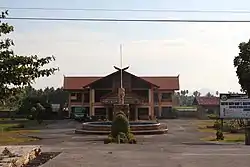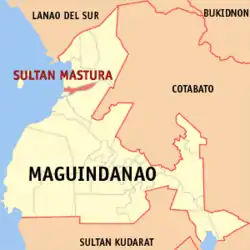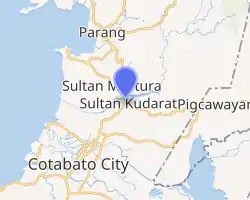Sultan Mastura
Sultan Mastura, officially the Municipality of Sultan Mastura (Maguindanaon: Ingud nu Sultan Mastura; Iranun: Inged a Sultan Mastura; Tagalog: Bayan ng Sultan Mastura), is a 5th class municipality in the province of Maguindanao, Philippines. According to the 2015 census, it has a population of 22,261 people. [3]
Sultan Mastura | |
|---|---|
| Municipality of Sultan Mastura | |
 Municipal Hall of Sultan Mastura | |
 Map of Maguindanao with Sultan Mastura highlighted | |
OpenStreetMap 
| |
.svg.png.webp) Sultan Mastura Location within the Philippines | |
| Coordinates: 7°17′00″N 124°18′00″E | |
| Country | |
| Region | Bangsamoro Autonomous Region in Muslim Mindanao (BARMM) |
| Province | Maguindanao |
| District | 1st District |
| Founded | April 28, 2003 |
| Barangays | 13 (see Barangays) |
| Government | |
| • Type | Sangguniang Bayan |
| • Mayor | Rauf T. Mastura |
| • Vice Mayor | Julhani M. Tumbas Jr. |
| • Representative | Datu Roonie Q. Sinsuat Sr. |
| • Electorate | 15,345 voters (2019) |
| Area | |
| • Total | 242.07 km2 (93.46 sq mi) |
| Elevation | 29 m (95 ft) |
| Highest elevation | 114 m (374 ft) |
| Lowest elevation | 0 m (0 ft) |
| Population | |
| • Total | 22,261 |
| • Density | 92/km2 (240/sq mi) |
| • Households | 3,832 |
| Economy | |
| • Income class | 5th municipal income class |
| • Poverty incidence | 52.03% (2015)[4] |
| • Revenue | ₱70,870,742.53 (2016) |
| Service provider | |
| • Electricity | Maguindanao Electric Cooperative |
| Time zone | UTC+8 (PST) |
| ZIP code | 9605 |
| PSGC | |
| IDD : area code | +63 (0)64 |
| Climate type | tropical climate |
| Native languages | Maguindanao Iranun Tagalog |
It was created by virtue of the Muslim Mindanao Autonomy Act No. 89, carved from the municipality of Sultan Kudarat.[5] The law was submitted on September 13, 1999 and lapsed into law on November 13, 1999. It was ratified by the people of Sultan Mastura through plebiscite on March 15, 2003. Its corporate existence started on April 28, 2003.
It was part of the province of Shariff Kabunsuan from October 2006 until its nullification by the Supreme Court in July 2008.
Geography
Barangays
Sultan Mastura is politically subdivided into 13 barangays.
- Balut
- Boliok
- Bungabong
- Dagurongan
- Kirkir
- Macabico (Macabiso)
- Namuken
- Simuay/Seashore
- Solon
- Tambo
- Tapayan
- Tariken
- Tuka
Climate
| Climate data for Sultan Mastura, Maguindanao | |||||||||||||
|---|---|---|---|---|---|---|---|---|---|---|---|---|---|
| Month | Jan | Feb | Mar | Apr | May | Jun | Jul | Aug | Sep | Oct | Nov | Dec | Year |
| Average high °C (°F) | 28 (82) |
28 (82) |
29 (84) |
29 (84) |
27 (81) |
26 (79) |
26 (79) |
26 (79) |
27 (81) |
26 (79) |
27 (81) |
27 (81) |
27 (81) |
| Average low °C (°F) | 19 (66) |
19 (66) |
19 (66) |
20 (68) |
21 (70) |
20 (68) |
20 (68) |
20 (68) |
20 (68) |
20 (68) |
20 (68) |
19 (66) |
20 (68) |
| Average precipitation mm (inches) | 53 (2.1) |
44 (1.7) |
41 (1.6) |
39 (1.5) |
69 (2.7) |
89 (3.5) |
92 (3.6) |
97 (3.8) |
72 (2.8) |
79 (3.1) |
72 (2.8) |
49 (1.9) |
796 (31.1) |
| Average rainy days | 15.3 | 13.5 | 16.3 | 16.9 | 22.3 | 23.5 | 22.5 | 23.1 | 19.4 | 21.5 | 20.6 | 17.5 | 232.4 |
| Source: Meteoblue (modeled/calculated data, not measured locally)[6] | |||||||||||||
Demographics
| Year | Pop. | ±% p.a. |
|---|---|---|
| 2007 | 25,741 | — |
| 2010 | 21,712 | −6.01% |
| 2015 | 22,261 | +0.48% |
| Source: Philippine Statistics Authority [3] [7] [8][9] | ||
References
- Municipality of Sultan Mastura | (DILG)
- "Province: Maguindanao". PSGC Interactive. Quezon City, Philippines: Philippine Statistics Authority. Retrieved 12 November 2016.
- Census of Population (2015). "ARMM – Autonomous Region in Muslim Mindanao". Total Population by Province, City, Municipality and Barangay. PSA. Retrieved 20 June 2016.
- https://psa.gov.ph/sites/default/files/City%20and%20Municipal-level%20Small%20Area%20Poverty%20Estimates_%202009%2C%202012%20and%202015_0.xlsx; publication date: 10 July 2019; publisher: Philippine Statistics Authority.
- "Muslim Mindanao Autonomy Act No. 89; An Act Creating the Municipality of Sultan Mastura in the Province of Maguindanao, Authorizing the Appropriation of Funds therefor, and for Other Purposes" (PDF). Regional Legislative Assembly, Autonomous Region in Muslim Mindanao. Retrieved 27 January 2016.
- "Sultan Mastura, Maguindanao : Average Temperatures and Rainfall". Meteoblue. Retrieved 19 January 2019.
- Census of Population and Housing (2010). "ARMM – Autonomous Region in Muslim Mindanao". Total Population by Province, City, Municipality and Barangay. NSO. Retrieved 29 June 2016.
- Censuses of Population (1903–2007). "ARMM – Autonomous Region in Muslim Mindanao". Table 1. Population Enumerated in Various Censuses by Province/Highly Urbanized City: 1903 to 2007. NSO.
- "Province of Maguindanao". Municipality Population Data. Local Water Utilities Administration Research Division. Retrieved 17 December 2016.
- "Poverty incidence (PI):". Philippine Statistics Authority. Retrieved 28 December 2020.
- https://psa.gov.ph/sites/default/files/2006%20and%202009%20City%20and%20Municipal%20Level%20Poverty%20Estimates_0_1.pdf; publication date: 3 August 2012; publisher: Philippine Statistics Authority.
- https://psa.gov.ph/sites/default/files/2012%20Municipal%20and%20City%20Level%20Poverty%20Estima7tes%20Publication%20%281%29.pdf; publication date: 31 May 2016; publisher: Philippine Statistics Authority.
- https://psa.gov.ph/sites/default/files/City%20and%20Municipal-level%20Small%20Area%20Poverty%20Estimates_%202009%2C%202012%20and%202015_0.xlsx; publication date: 10 July 2019; publisher: Philippine Statistics Authority.